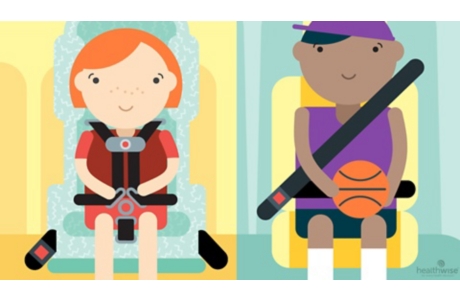Child Car Seats
Topic Overview
Infant and child car seats save lives. By law, children must be buckled up in a car seat that is made for their weight, height, and age. Check your state’s laws at www.iihs.org/laws/default.aspx.
A child who is not in a car seat can be seriously injured or killed during a crash or an abrupt stop, even at low speeds. A parent’s arms are not strong enough to hold and protect a baby during a car accident. Many unrestrained children die because they are torn from an adult’s arms during a crash.
Set a good example for your children by always wearing your own seat belt, and always insist that they buckle up.
Requirements for car seats
Buy a car seat appropriate for your child’s current age, weight, and height. For safety, it is very important to have a car seat that fits your child and faces the right direction. Be sure to follow the car seat maker’s recommendations. They should include weight and height guidelines. They should also tell you how to install the seat and how to secure your child in it.
The following guidelines come from the National Highway Traffic Safety Administration (NHTSA):
Ages 0 to 12 months
Your child younger than age 1 should always ride in a car seat that faces the back of the car (called rear-facing). There are different types of rear-facing car seats. Infant-only seats can only be used rear-facing. Convertible and 3-in-1 car seats typically have higher height and weight limits for the rear-facing position, allowing you to keep your child rear-facing for a longer period of time.
Ages 1 to 3 years
Keep your child rear-facing in a convertible or 3-in-1 car seat as long as possible. It’s the best way to keep him or her safe. Your child should remain rear-facing until he or she reaches the top height or weight limit allowed by your car seat’s maker. As soon as your child outgrows the rear-facing car seat, your child is ready to travel in a car seat that faces the front (called forward-facing) and that has a harness.
Ages 4 to 7 years
Keep your child in a forward-facing car seat with a harness until he or she reaches the top height or weight limit allowed by your car seat’s maker. As soon as your child outgrows the forward-facing car seat with a harness, your child can travel in a booster seat but still in the back seat.
Ages 8 to 12 years
Keep your child in a booster seat until he or she is big enough to fit in a seat belt properly. For a seat belt to fit properly, the lap belt must lie snugly across the upper thighs, not the stomach. The shoulder belt should lie snug across the shoulder and chest and not cross the neck or face. Remember: Your child should still ride in the back seat because it’s safer there.
Don’t buy a used car seat. If a car seat has been recalled or has been in an accident or misused, it may not fully protect your baby.
Proper positioning
The safest position for your baby or child is in the back, middle seat of the car.
- Do not place your child’s car seat in the front seat of any vehicle with a passenger side air bag that cannot be turned off.
- Do not allow a child younger than age 13 to sit in the front seat of any vehicle.
- Make sure your infant’s car seat is at an angle where his or her head does not flop forward.
- It is okay for your baby to fall asleep while traveling as long as the straps are in the right position. Do not put your baby down to sleep in a car seat. It should only be used for travel.
- Take extra care if you have a premature infant. Slouching may affect his or her breathing and oxygen supply.
For maximum safety, follow the manufacturer’s recommendations for car seat use. Cars manufactured since September 2002 are equipped with a standardized car safety seat attachment system. This feature allows parents to secure the car seat on a permanently installed hook.
Certified Child Passenger Safety Technicians can help you install your car seat and position your child safely. To find help in your area, go to www.nhtsa.dot.gov/cps/cpsfitting/index.cfm or www.seatcheck.org. You can also call the National Highway Traffic Safety Administration at 1-888-327-4236.
Do not let your child get out of his or her seat while the car is moving. If your child needs attention, stop the car, take the child out of the seat, take care of his or her needs, and put him or her back into the seat before the car starts moving again. If your child is fussy again soon after, stop and check your child again.
Current as of: December 12, 2018
Author: Healthwise Staff
Medical Review:Susan C. Kim MD – Pediatrics & Kathleen Romito MD – Family Medicine & John Pope MD – Pediatrics
This information does not replace the advice of a doctor. Healthwise, Incorporated, disclaims any warranty or liability for your use of this information. Your use of this information means that you agree to the Terms of Use. Learn how we develop our content.





